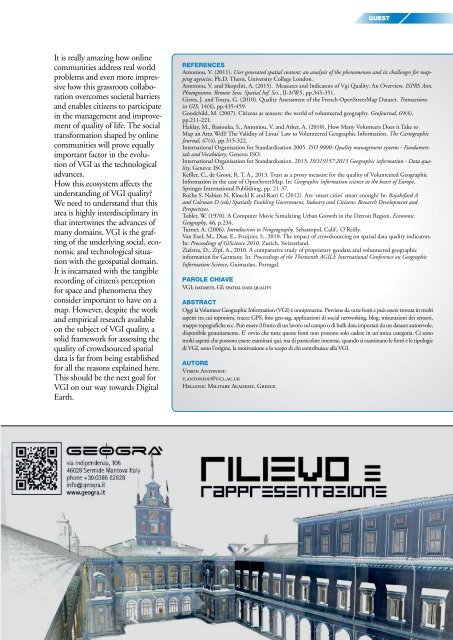Create successful ePaper yourself
Turn your PDF publications into a flip-book with our unique Google optimized e-Paper software.
GUEST<br />
It is really amazing how online<br />
communities address real world<br />
problems and even more impressive<br />
how this grassroots collaboration<br />
overcomes societal barriers<br />
and enables citizens to participate<br />
in the management and improvement<br />
of quality of life. The social<br />
transformation shaped by online<br />
communities will prove equally<br />
important factor in the evolution<br />
of VGI as the technological<br />
advances.<br />
How this ecosystem affects the<br />
understanding of VGI quality?<br />
We need to understand that this<br />
area is highly interdisciplinary in<br />
that intertwines the advances of<br />
many domains. VGI is the grafting<br />
of the underlying social, economic<br />
and technological situation<br />
with the geospatial domain.<br />
It is incarnated with the tangible<br />
recording of citizen’s perception<br />
for space and phenomena they<br />
consider important to have on a<br />
map. However, despite the work<br />
and empirical research available<br />
on the subject of VGI quality, a<br />
solid framework for assessing the<br />
quality of crowdsourced spatial<br />
data is far from being established<br />
for all the reasons explained here.<br />
This should be the next goal for<br />
VGI on our way towards Digital<br />
Earth.<br />
REFERENCES<br />
Antoniou, V. (2011). User generated spatial content: an analysis of the phenomenon and its challenges for mapping<br />
agencies. Ph.D. Thesis, University College London.<br />
Antoniou, V. and Skopeliti, A. (2015). Measures and Indicators of Vgi Quality: An Overview. ISPRS Ann.<br />
Photogramm. Remote Sens. Spatial Inf. Sci., II-3/W5, pp.345-351.<br />
Girres, J. and Touya, G. (2010). Quality Assessment of the French OpenStreetMap Dataset. Transactions<br />
in GIS, 14(4), pp.435-459.<br />
Goodchild, M. (2007). Citizens as sensors: the world of volunteered geography. GeoJournal, 69(4),<br />
pp.211-221.<br />
Haklay, M., Basiouka, S., Antoniou, V. and Ather, A. (2010). How Many Volunteers Does it Take to<br />
Map an Area Well? The Validity of Linus’ Law to Volunteered Geographic Information. The Cartographic<br />
Journal, 47(4), pp.315-322.<br />
International Organisation for Standardisation 2005. ISO 9000: Quality management systems - Fundamentals<br />
and Vocabulary, Geneva: ISO.<br />
International Organisation for Standardisation, 2013. ISO19157:2013 Geographic information - Data quality,<br />
Geneva: ISO.<br />
Keßler, C., de Groot, R. T. A., 2013. Trust as a proxy measure for the quality of Volunteered Geographic<br />
Information in the case of OpenStreetMap. In: Geographic information science at the heart of Europe,<br />
Springer International Publishing, pp. 21-37.<br />
Roche S, Nabian N, Kloeckl K and Ratti C (2012). Are ‘smart cities’ smart enough? In: Rajabifard A<br />
and Coleman D (eds) Spatially Enabling Government, Industry and Citizens: Research Development and<br />
Perspectives.<br />
Tobler, W. (1970). A Computer Movie Simulating Urban Growth in the Detroit Region. Economic<br />
Geography, 46, p.234.<br />
Turner, A. (2006). Introduction to Neogeography. Sebastopol, Calif.: O’Reilly.<br />
Van Exel, M., Dias, E., Fruijtier, S., 2010. The impact of crowdsourcing on spatial data quality indicators.<br />
In: Proceedings of GiScience 2010, Zurich, Switzerland.<br />
Zielstra, D., Zipf, A., 2010. A comparative study of proprietary geodata and volunteered geographic<br />
information for Germany. In: Proceedings of the Thirteenth AGILE International Conference on Geographic<br />
Information Science, Guimarães, Portugal.<br />
PAROLE CHIAVE<br />
VGI; datasets, GI; spatial data quality<br />
ABSTRACT<br />
Oggi la Volunteer Geographic Information (VGI) è onnipresente. Proviene da varie fonti e può essere trovata in molti<br />
aspetti tra cui toponimi, tracce GPS, foto geo-tag, applicazioni di social networking, blog, misurazioni dei sensori,<br />
mappe topografiche ecc. Può essere il frutto di un lavoro sul campo o di bulk data importati da un dataset autorevole,<br />
disponibile gratuitamente. E' ovvio che tutte queste fonti non possono solo cadere in un'unica categoria. Ci sono<br />
molti aspetti che possono essere esaminati qui, ma di particolare interesse, quando si esaminano le fonti e le tipologie<br />
di VGI, sono l'origine, la motivazione e lo scopo di chi contribuisce alla VGI.<br />
AUTORE<br />
Vyron Antoniou<br />
v.antoniou@ucl.ac.uk<br />
Hellenic Military Academy, Greece<br />
<strong>GEOmedia</strong> n°1-<strong>2016</strong> 45


















